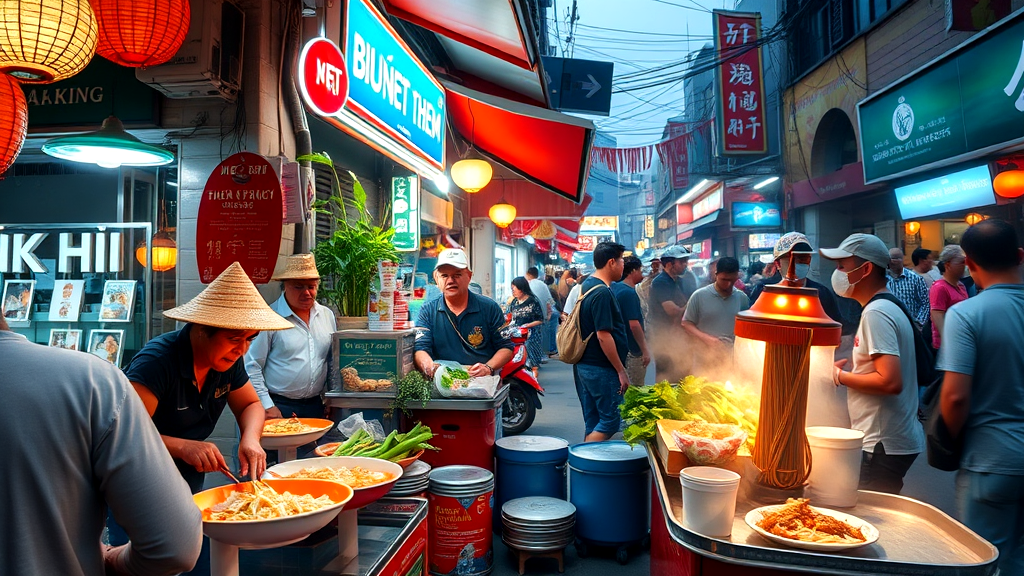Being precise with translation is like threading a needle
It’s tricky, especially with Vietnamese dishes like bún chả and bún thịt nướng. I once thought they were the same. Boy, was I wrong! Bún chả from the North is famous for its grilled pork and noodle soup, while bún thịt nướng from the South is all about dry noodles and fresh herbs. These regional delights highlight the rich diversity among Vietnamese people. It’s not just about food, though. Each dish tells a cultural tale. As I explored the vibrant streets of Hoan Kiem District in Hanoi, I realized how crucial these nuances are. Let’s dive into these tasty stories and savor Vietnam’s culinary tapestry.
Key Takeaways
- AI often struggles with translation, missing cultural nuances in Vietnamese dishes like bún chả and bún thịt nướng.
- Bún chả, popular in the North, combines grilled pork with noodle soup.
- Bún thịt nướng, from the South, features dry noodles with fresh herbs.
- These dishes highlight the rich diversity and cultural stories of Vietnamese people.
- Exploring places like Hoan Kiem District reveals the importance of these culinary nuances.

Understanding the subtle differences between Vietnam’s bún chả and bún thịt nướng reveals a lot. These dishes, rooted in the country’s regions, highlight unique flavors and traditions. In the North, bún chả brings smoky grilled pork and fresh herbs. Meanwhile, the South’s bún thịt nướng showcases a sweeter, aromatic twist with lemongrass.
Food isn’t just about taste; it’s a language of culture and history. When AI overlooks these nuances, it misses the full picture. I find it fascinating how food can tell stories and connect us to places and people. As we dive into these culinary worlds, we embrace a richer understanding beyond just what’s on the plate. I hope to savor more of these stories in every bite.
FAQ
- What’s the main difference between bún chả and bún thịt nướng?
Bún chả is a dish from Hanoi, featuring grilled pork served with rice noodles and a dipping sauce. Bún thịt nướng hails from Southern Vietnam, consisting of grilled pork with rice noodles, often topped with herbs and spring rolls. Both are delicious but have unique flavors and ingredients.
- How does AI typically fail in understanding food nuances?
AI struggles with context and cultural subtleties. It might not grasp regional dish variations or ingredient importance. For example, it may not distinguish between the different types of Vietnamese noodle dishes or their specific regional origins.
- Why is it important to recognize these culinary differences?
Understanding these differences enriches cultural appreciation and culinary experiences. It helps in recognizing the diversity within cuisines and respecting regional traditions. Plus, it makes for a more authentic dining experience.
- Can AI improve in understanding such nuances over time?
Yes, AI can improve with better data and learning algorithms. However, it still requires human input to fully appreciate cultural contexts. Continuous updates and diverse data sources are essential for improvement.
- What makes Vietnamese cuisine diverse and rich in flavor?
Vietnamese cuisine is influenced by geography, climate, and history. Each region offers distinct flavors, from Northern savory dishes to Southern sweet and spicy ones. Fresh herbs, fish sauce, and rice-based ingredients are staples, adding to its complexity and appeal.
Understanding the regional nuances from North to South not only enhances your appreciation of Vietnamese food but also provides insight into the country’s diverse cultural identity. It’s a journey of flavor that speaks to Vietnam’s history, geography, and the heart of its people.
In the North of Vietnam, dishes like bún chả feature grilled pork served with a tangy broth, highlighting subtle and balanced flavors. Meanwhile, in the South, bún thịt nướng offers a sweeter, more aromatic experience with lemongrass-marinated pork over noodles. Each region’s cuisine reflects its unique cultural and historical influences, making every bite a journey through Vietnam’s rich culinary heritage.




